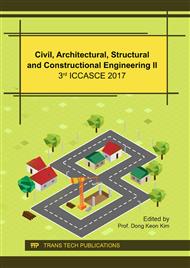[1]
G. Kopp, et al., New Lightweight Structures for Advanced Automotive Vehicles–Safe and Modular. Proc. Soc. Behav. Sci. 48 (2012)350-362.
Google Scholar
[2]
E. Mahdi, A. Hamouda, Energy absorption capability of composite hexagonal ring systems. Mater. Des. 34 (2012) 201-210.
DOI: 10.1016/j.matdes.2011.07.070
Google Scholar
[3]
L. Yan, N. Chouw, Crashworthiness characteristics of flax fibre reinforced epoxy tubes for energy absorption application. Mater. Des. 51 (2013) 629-640.
DOI: 10.1016/j.matdes.2013.04.014
Google Scholar
[4]
H. Yin, et al., Multiobjective crashworthiness optimization of functionally lateral graded foam-filled tubes. Mater. Des. 44 (2013) 414-428.
DOI: 10.1016/j.matdes.2012.08.033
Google Scholar
[5]
R. A. Eshkoor, et al., Comparative research on the crashworthiness characteristics of woven natural silk/epoxy composite tubes. Mater. Des. 47 (2013) 248-257.
DOI: 10.1016/j.matdes.2012.11.030
Google Scholar
[6]
S. Ebrahimi, N. Vahdatazad, Multiobjective optimization and sensitivity analysis of honeycomb sandwich cylindrical columns under axial crushing loads. Thin-Wall. Struct. 88 (2015) 90-104.
DOI: 10.1016/j.tws.2014.12.004
Google Scholar
[7]
S. Palanivelu, et al., Crushing and energy absorption performance of different geometrical shapes of small-scale glass/polyester composite tubes under quasi-static loading conditions. Comp. Struct. 93(2) (2011) 992-1007.
DOI: 10.1016/j.compstruct.2010.06.021
Google Scholar
[8]
S. Ochelski, P. Gotowicki, Experimental assessment of energy absorption capability of carbon-epoxy and glass-epoxy composites. Comp. Struct. 87(3) (2009) 215-224.
DOI: 10.1016/j.compstruct.2008.01.010
Google Scholar
[9]
E. Mahdi, et al., Effect of hybridisation on crushing behaviour of carbon/glass fibre/epoxy circular–cylindrical shells. J. Mater. Proc. Tech. 132(1) (2003) 49-57.
DOI: 10.1016/s0924-0136(02)00260-1
Google Scholar
[10]
P. Paruka, M. K. M. Shah, M. A. Mannan, Influence of axial and oblique impact loads on crush response properties of square tube structures made with FRP pultruded composites. Proc. Eng. 68 (2013) 572-578.
DOI: 10.1016/j.proeng.2013.12.223
Google Scholar
[11]
A. Baroutaji, et al., Analysis and optimization of sandwich tubes energy absorbers under lateral loading. Int. J. Imp. Eng. 82 (2015) 74-88.
DOI: 10.1016/j.ijimpeng.2015.01.005
Google Scholar
[12]
L. Hu, F. You, T. Yu, Effect of cell-wall angle on the in-plane crushing behaviour of hexagonal honeycombs. Mater. Des. 46 (2013) 511-523.
DOI: 10.1016/j.matdes.2012.10.050
Google Scholar
[13]
R. J. D'Mello, A. M. Waas, Inplane crush response and energy absorption of circular cell honeycomb filled with elastomer. Comp. Struct. 106 (2013) 491-501.
DOI: 10.1016/j.compstruct.2013.05.054
Google Scholar
[14]
J. O. Hallquist, LS-DYNA3D theoretical manual. Livermore software technology corporation, (1993).
Google Scholar
[15]
P. Feraboli, et al., LS-DYNA MAT54 modeling of the axial crushing of a composite tape sinusoidal specimen. Comp. Part A: Appl. Sci. Manuf. 42(11) (2011) 1809-1825.
DOI: 10.1016/j.compositesa.2011.08.004
Google Scholar
[16]
D. Siromani, J. Awerbuch, T. M. Tan, Finite element modeling of the crushing behavior of thin-walled CFRP tubes under axial compression. Comp. Part B: Eng. 64 (2014) 50-58.
DOI: 10.1016/j.compositesb.2014.04.008
Google Scholar
[17]
H. El-Hage, P. Mallick, N. Zamani, Numerical modelling of quasi-static axial crush of square aluminium-composite hybrid tubes. Int. J. Crashworth. 9(6) (2004) 653-664.
DOI: 10.1533/ijcr.2004.0320
Google Scholar


